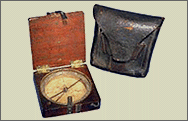
by Evelyn Porreca Vuko
Grades 6-8
In this lesson, students replicate some of the trailblazing methods of Lewis and Clark on a fifteen-minute "writing journey" through the school or neighborhood. Thomas Jefferson helps. Students follow his instructions to Meriwether Lewis on taking notes, making scientific observations, charting distances, and compiling data. They create new names for locations passed along the way, and they mark the end of the trail by hiding a small token.
Once back at "base camp," they plot their maps and amend their notes. For homework, each student writes a descriptive, sequential narrative. Then comes the proof. Is the journey so clearly described and accurately sequenced that a student from another class can use it to retrace the route and bring back the object?
The full text of Jefferson's instructions is available at the website of the Fort Clatsop National Memorial.
Objectives
- To use organizing and mapping skills to reinforce the skill of writing in temporal and sequential order
- To activate history through personal links to historical figures
Materials
- graph paper
- pencils
- compass
- tape measure
- printouts of instructions
- small object to use as a token
Teacher Preparation
(20 minutes)
- Seek out a roundtrip route through your school or neighborhood.
- Note story-rich sights along the way. (On a winter expedition with my students, I pointed out an immense poinsettia on the school secretary's desk. Its size and brilliant foliage made it noteworthy. What made it "story rich" was that it was a gift from a group of grateful substitute teachers.)
- Select landmarks that students might name.
- At the farthest point from the start (7-8 minutes out) find a place to hide the token-a Sacagawea dollar, perhaps, or a seashell to symbolize the Pacific Ocean.
Part One: The Instructions
(20-25 minutes)
Distribute copies of Jefferson's instructions on page 14. Appoint two responsible students to serve as your Lewis and your Clark. They will note compass direction changes and measure the distance of each portion, or "leg," of the journey. For example, one leg could be the distance between the classroom and the cafeteria.
They might measure one leg by tape measure, the rest by counting paces or floor tiles. Though meticulous measurements were a hallmark of the Lewis andClark expedition, you may not have time to be so precise in this lesson. Review Jefferson's quotes. Students might use the back of the photocopied page for their own notes. They will use the notes later for plotting a map and writing a composition.
Part Two: The Expedition
(15-20 minutes)
- Conduct students along the trail you set. Note aloud the starting time and the compass direction of the first leg of the expedition.
- Whenever the expedition changes direction, have the distance measurer announce the distance of the just-completed leg. Have the compass reader announce the new compass reading (or use left-and right directions).
- Point out locations to be given new names.
4. Announce the ending time and distance of the final leg. Have students hide the token.
Part Three: Back at Base Camp
(20-25 minutes)
Back in the classroom, students might use graph paper to map their trip. Encourage them to work as partners or in teams to amend and complete their maps and notes.
Part Four: Writing the Report
(30-45 minutes)
Assign a two-or three-page composition for homework. Students should use their map and notes to describe the journey in sequential order.
Part Five: Is the Trail Blazed?
(15-20 minutes)
Will the traveler reach the goal? Evaluate each map and composition, and staple the two together. Next, place the sets face down on a desk or table. Invite a student from another class (or one who was absent) to travel the route. Have the traveler randomly select one map-and-composition set from the pile. Provide a compass and tape measure.
Direct the traveler to use this information to follow the route and bring back the object hidden on the trail. Set a fifteen-minute time limit. A teacher's aid or classroom helper should accompany the traveler to act as timekeeper and silent observer.
Lewis and Clark created place-names that ranged from the bitterly matter-of-fact to the sentimental. In the Bitterroot Mountains, they named a stream Hungery Creek because, said Clark, "at that place we had nothing to eate." Because a river reminded Lewis of a woman he thought of as "that lovely fair one," he named it Marias River.
Encourage students to use characteristics, events, problems, and feelings to create their names. One of my students named the cafeteria Nausea Central. To another student, it might be Middle School Dance Place. Naming the cafeteria has even inspired students who tend to use the same three adjectives in their writing: good, bad, and O.K.
Evelyn Porreca Vuko is a veteran classroom teacher and school administrator. Her column, Teacher Says, appears monthly in the Washington Post and online at www.washingtonpost.com. Her Web address is www.teachersays.com.
|
 |
 |
 |
 |

Lewis and Clark compass. National Museum of American History, Smithsonian Institution.
|
 |
 |

|
 |
 |
 |
|

